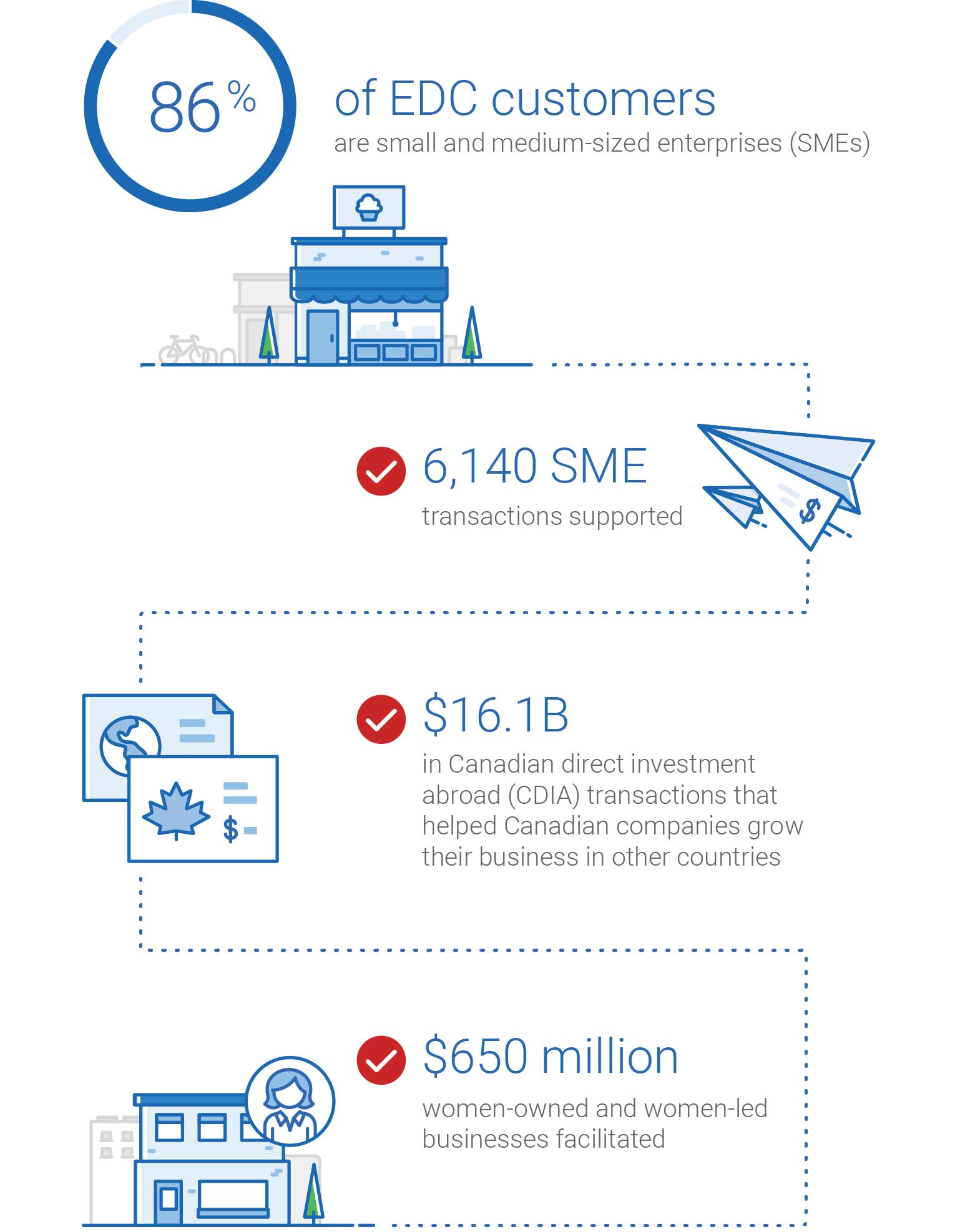Export Development Canada (EDC) helps Canadian companies succeed in markets across the world – and not just big companies. Close to nine out of 10 businesses they help with international growth are small to mid-sized, like yours.1
Source: 2019 EDC Corporate Results. Click the image to view an accessible PDF.
Shipping from Canada to China: A sizeable opportunity
In October 2020, online retail sales of physical goods in China accounted for 24 per cent of their total retail sales2 (compared to 14 per cent in the U.S.3). China is currently the largest e-commerce market in the world, almost double the size of the U.S. Canada ranks eighth in the world for e-commerce, with annual online sales of $30 million.4
China’s e-commerce market
E-commerce in China is booming and they owe their head start to force of circumstance. In 2003, when SARS hit Asia harder than the rest of the world, retailers had to find new ways of connecting with customers. This is what spurred the founder of JD.com to pivot his physical retail business and bring it online. Fast forward to 2020, and Singles’ Day event sales totalled U.S. $120 billion for Alibaba and JD.com alone. By comparison, in 2019, the entirety of Thanksgiving, Black Friday and Cyber Monday sales amounted to U.S. $28 billion.5 In 2020, Canadian e-commerce vaulted five years. COVID-19 has accelerated a lot of trends and behaviours that were already in motion, and they’ve fast become habits. Online retailing mindsets have changed, horizons are expanding and Canadian online merchants are ready to embrace their next chapter.
Discover a world of opportunity when you decode opportunities for Canadian online retailers in China.
View on demandEntering an international marketplace: How to expand into Asia
If you’ve got expansion plans, where should you start? Bryan Sirois is a Global Trade Director at EDC and an international e-commerce expert. At a highly anticipated virtual event in September 2020, he shared the latest secrets that have Canadian businesses thinking like e-commerce leaders. Misko Kanko is a global strategist at Canada Post and advises Canadian companies on how to develop their e-presence in Asian markets. They both know that, compared to other international markets, e-commerce in China calls for new ways of thinking and careful consideration of risks and rewards.
China is where small companies go to think big. According to Canada’s Trade Commissioner Service (TCS), working with a trade partner to export to China from Canada provides customers with the wealth of expertise and knowledge required to manage the various platforms, provide localized customer service, manage returns and optimize marketing and advertising spend.
To help you get ahead, we’ve compiled the wisdom of these experts into 10 helpful tips. Lean on their advice to figure out the priorities and pitfalls when extending your online operations into China.
Ten tips for e-commerce success in China:
- Find your focus. The big categories are food (groceries and delivery), apparel, cosmetics, and maternity and baby. As a result of the pandemic, anything to do with health is now massive. Markets are huge, so target geographically. You don’t need to sell to all of China. It’s possible to win big by focusing marketing and advertising efforts on just one province.
Four major e-commerce categories include groceries and delivery, apparel, cosmetics, and maternity and baby.
- Differentiate yourself from your competitors. Brand recognition and allegiance are super important. Build your brand to stand out. Retailers from around the world are eyeing the same markets as you. Success rises to the surface. What is it you offer that’s unique? What does your product give to consumers in a new market that they can’t already get? Telling a story is critical in China – much more so than in most other markets. If you and your product have an interesting story to tell, be sure to lean on it.
Ssense.com‘s website. Ssense.com is a marketplace for luxury fashion.
- Be where your customers are. Mobile, brick and mortar, social? Do your research. For social media, look beyond the obvious choices like WeChat and explore Sina Weibo, Tencent QQ and Xiaohongshu.
WeChat, QQ, Xiaohongshu, and Sina Weibo.
- Cater to your customers. Customer service should be 24/7 and should reflect local language and dialects. Time zones are to be respected. Not being online is not an option. Having a .cn website hosted in China is critical because bandwidth is throttled in peak hours. Any delays could cost you sales. Your website will serve primarily as a marketing tool. What will it look like?
- Pick expert partners. Learn to lean on a combination of Canadian and local experts to guide you. Business practices in China are different. Avoid costly mistakes by learning from the accumulated experience of knowledgeable agencies. The Government of Canada’s Trade Commissioner Service offers An Introduction to E-commerce in China.
- Provide user-friendly payment options. Offering the easiest ways to pay means abandoning your current mindset and methods. WeChat, for example, is a Chinese multi-purpose messaging, social media and mobile payment app with 1.2 billion users. Shopify merchants can accept payments through Alipay, Asia’s leading digital wallet platform. Make your prices competitive. China buys from all over the world.
- Access resources and support. Do you have the resources to expand? How will you finance your growth? Is your network already established? You’re going to need investment, insurance and connections to support your next move. EDC can help Canadian companies access capital. It offers insurance protection to companies doing business beyond our borders. The crown corporation also connects Canadian and international companies to help both parties grow.
- Explore supply-chain logistics for omni-channel fulfillment. Pay close attention to these. Think about your target markets. Where do you want to be present and, if you need to fulfill in market, how will your orders get delivered efficiently? Do you need to manufacture in China and be represented in multiple locations across a vast geography? Don’t forget that logistics work both ways. To match your delivery and distribution, you need to know you have an easy, friendly returns system in place.
- Pick the right marketplace platform(s) for your business. In China, most online business is done through marketplaces. It’s also where many product searches start. Alibaba and JD account for over 80 per cent of the market.6 An online marketplace provides instant access to high volumes of traffic. Most of them provide fulfillment services for storage, picking, packing, shipping and returns. They allow you to avoid upfront investment for e-commerce infrastructure.
Source: “JD vs. Alibaba- E-Commerce War of China”, Eastwestbank.com, January 11, 2016.
Do you know whether a niche platform or a leading mass-marketplace is right for you? What’s important is to determine which channels make the most sense for your business.
The Chinese e-commerce market is extremely competitive, so choosing the right platform is crucial. A major benefit to Alibaba’s Tmall Global and JD.com Worldwide is that they allow international companies without Chinese business licenses to sell their products more easily and conveniently in China’s market. The cross-border online malls are a lower-risk approach to entering the market.
- Diversify. Could this be the big lesson of 2020? Consider every option to mitigate risks and open up opportunities. Apply new thinking to supply chains, buyer bases, media channels, customer touchpoints and content options. There are always flexible new ways of achieving the next big thing.
To access more expert knowledge about international e-commerce, download the EDC Export Help Hub from the Shopify app store.
Sources:
1 2019 EDC Corporate Results.
2 “China retail sales grew 4.3% in Oct 2020; online over 24% of total”, China Internet Watch, November 2020.
3 “Quarterly Retail E-commerce Sales 3rd Quarter 2020”, U.S. Census Bureau, November 2020.
4 “The 10 Largest E-commerce Markets in the World by Country”, Business.com, April 2020.
5 “Chinese Singles’ Day Blows Away Thanksgiving Weekend”, Statista.com, November 11, 2020.
6 “JD vs. Alibaba- E-Commerce War of China”, Eastwestbank.com, January 11, 2016.
Expand your e-commerce horizons.
Find the fastest route to online retail success internationally.
Click for international guide



